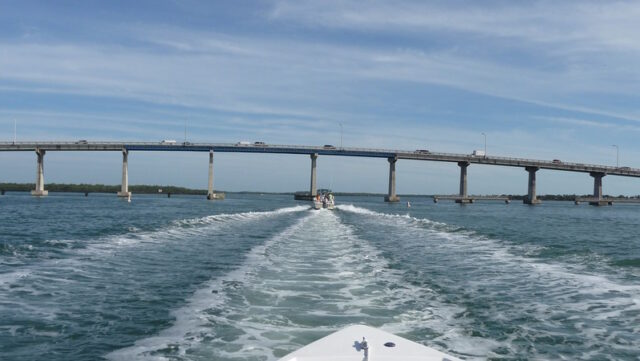
Reading Time: 10 minutes
In the angling world, Marco Island is famous for its rich coastal waters. It also offers easy access to the Everglades, which is one of Florida’s most exciting inshore fisheries. However, what some may not know is that deep sea fishing in Marco Island also has plenty going for it. As long as you’re willing to make the journey offshore, all kinds of exciting game fish await.

With deep sea fishing, it’s all about how far you’re willing to go and how much time on the water you can allot. From Marco Island, you can expect to go up to 10 miles offshore on shorter trips. On full days and longer adventures, you’ll get to venture deeper into the Gulf of Mexico. In those waters, you never know what prized fish is going to eat your bait next.
If you’d like to learn more about the fish you can catch while fishing offshore from Marco Island, read on. Besides introducing some of the commonly caught species, we’ll also go into a couple of techniques you’ll use and spots to visit. So scroll on!
What species can I catch deep sea fishing in Marco Island?
| Species | Jan | Feb | Mar | Apr | May | Jun | Jul | Aug | Sep | Oct | Nov | Dec |
|---|---|---|---|---|---|---|---|---|---|---|---|---|
| Snapper | Greaet | Great | Great | Great | Great | Great | Great | Great | Great | Great | Great | Great |
| Grouper | Great | Great | Great | Great | Great | Great | Great | Great | Great | Great | Great | Great |
| Cobia | Weak | Weak | Great | Great | Good | Good | Weak | Weak | Good | Great | Great | Good |
| King Mackerel | Great | Great | Good | Good | Weak | Weak | Weak | Good | Good | Great | Great | Great |
| Spanish Mackerel | Weak | Weak | Good | Good | Great | Great | Great | Great | Great | Great | Good | Weak |
| Amberjack | Great | Great | Good | Good | Weak | Weak | Weak | Weak | Good | Good | Great | Great |
In the deep seas off the coast of Marco Island, you’ll find a healthy mix of reef and pelagic fish. The action goes on year-round and there’ll be something you can go for regardless of when you visit. Check out some of the top Marco Island deep-sea catches.
Snapper
Similarly to the rest of the Gulf Coast, the waters off Marco Island are a treasure trove of Snapper. Multiple species of these fish can be caught out here, including Mangrove, Vermilion, Lane, Mutton, and Yellowtail. Of course, the ones anglers like seeing the most are the delicious Red Snapper.
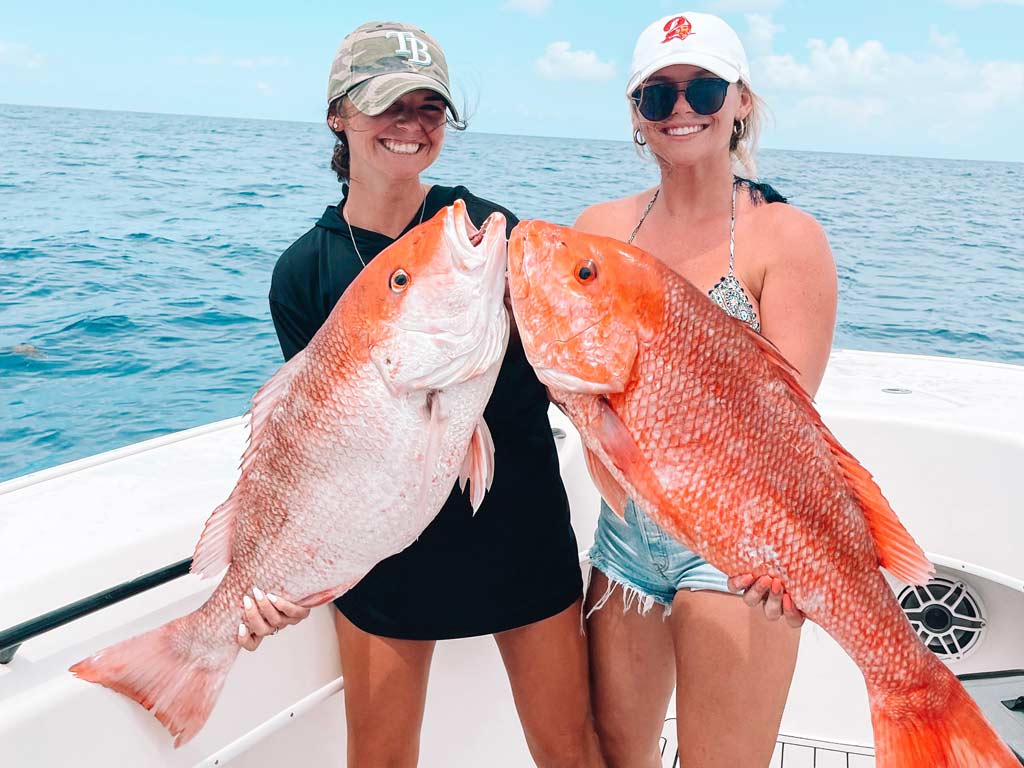
Found along the various reefs and wrecks off the Florida coast, Snapper will bite year-round, making them a standard target when deep sea fishing around Marco Island. Most Snapper can be harvested year-round, with the exception of Red Snapper. Their season lasts only for a month or two during summer, sometimes reopening for a few weekends in fall.
To get to the spots where Snapper lurk, you don’t necessarily need to wander too far. They’ll bite on the reefs within a few miles offshore. However, trophy-sized ones are caught in deeper, less pressured waters farther off the coast. Snapper are also great targets if you’re new to fishing – they’re fun to catch but relatively easy to reel in.
Grouper
While we’re on the topic of bottom fish, these waters are also home to different types of Grouper. Both they and Snapper are prized for their taste. However, Groupers are considered the better fighters between the two.
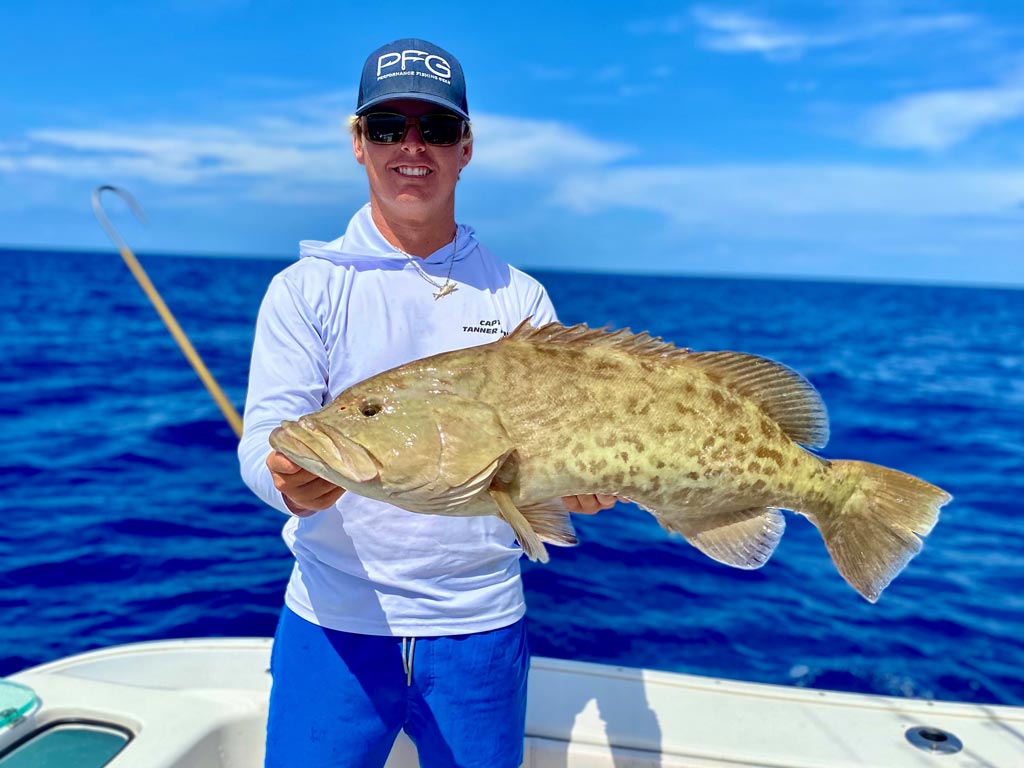
In fact, if you get lucky enough to face a Goliath Grouper, you’ll be in for a brutal, rod-bending battle unlike any other. Goliaths are seriously one of the toughest challenges you can face. They can reach several hundred pounds in weight, making it seem like you’re trying to reel in a car stuck on the seafloor.
Other Grouper species you’ll hook into while deep sea fishing off Marco Island are Red, Black, and Gag Grouper. They’re smaller, but still exciting to wrestle and they’ll bite all year round. You’ll find them along the same reefs and wrecks where you’d go for Snapper. The only thing you’ll really need to pay attention to are the regulations, as they change almost every year.
Cobia
Another species you’ll get to meet in the federal waters of the Gulf of Mexico is the “Man in the Brown Suit”, commonly known as Cobia. These fish are naturally curious, often taking the initiative and approaching fishing boats.
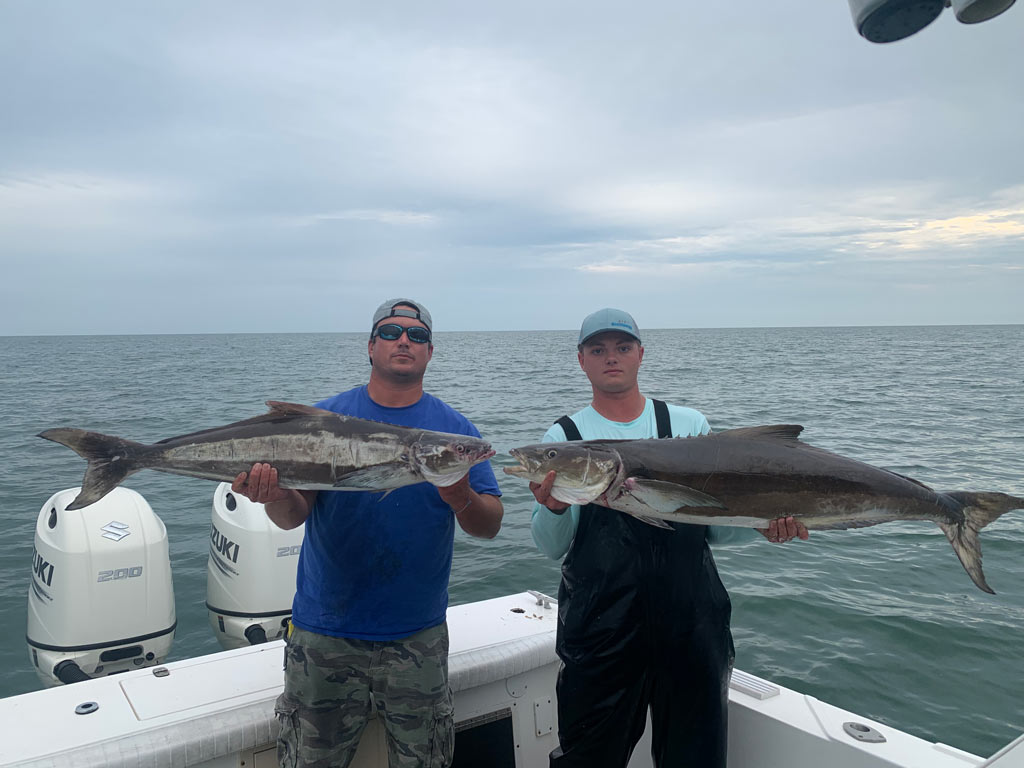
While this makes them a somewhat easy target when spotted, the fight itself is another story. Cobia are hardy fish, capable of long runs and great resistance. They’re also intelligent enough to flee to nearby structures to try and cut you off. It takes skill, stamina, and patience to land them successfully, so be prepared for an adrenaline-fueled experience.
Cobia normally move into the Gulf’s waters starting in spring. If you’re launching from Marco Island, this is the best time to fish for them. They’ll migrate northwards, before returning to the area again in the fall on their way out of the Gulf. Search for them offshore, around various structures that attract bait fish.
Spanish and King Mackerel
Among other seasonal visitors, Spanish and King Mackerel are also frequently found in the waters off Marco Island. Spanish Mackerel, as the smaller species between the two, are prized for their healthy meat and delicious taste. On the other hand, while King Mackerel don’t taste quite as good, they’re still decent eating. But more importantly, they put up a heck of a fight.

The cool part about fishing for Mackerel is that the two species you’ll target basically have opposite seasons. There’s some overlap, of course, but the best King Mackerel fishing in Marco Island takes place from October through March. On the other hand, Spanish Mackerel show up in spring and you can fish for them all the way until late fall.
Both species can be caught nearshore during their peak seasons. However, the King Mackerel action gets really hot once you’re 20 and more miles offshore. Out there, you’ll search for underwater ledges, hard bottoms, and wrecks, in the hope of running into big Kings. Spanish Mackerel are usually found closer to shore, making them the easier target.
And Others!
The species we named so far are a nice mix of year-round and seasonal residents that you’ll get to catch while deep sea fishing in Marco Island. They’re what you can realistically expect to find in these waters, provided you visit at the right time. With this in mind, there are many more fish you’ll also see go after your bait while you’re out there.

These include reef bruisers such as Amberjack, a whole host of different Sharks, as well as ravenous Barracuda. And if you’re willing to go far enough – we’re talking 40+ miles offshore – you might see Wahoo, Mahi Mahi, Tuna, and even the likes of Sailfish at the end of your line. As we mentioned at the beginning of the article, it’s all about how long you can stay on the water.
Marco Island Deep Sea Fishing Techniques
When you visit plays a crucial role in what you’ll get to catch. However, it’s also important how you choose to fish. To get to the offshore fishing grounds, you’ll need to hop on one of the federally-licensed deep sea charters in Marco Island. And once you’re out there, it’s the techniques you’ll use that’ll determine what you’ll hook into. So let’s go over a few common ways to fish here.
Trolling
When it comes to fishing for pelagic species, trolling is one of the most effective techniques to do so. Not only is it productive, but it’s also an easy way for anglers to fish aboard charter boats. Your captain will set up the trolling spread and bait all the hooks. At that point, all that’ll be needed from you is that you jump in on the action when the rod starts bending – and reel in that fish.
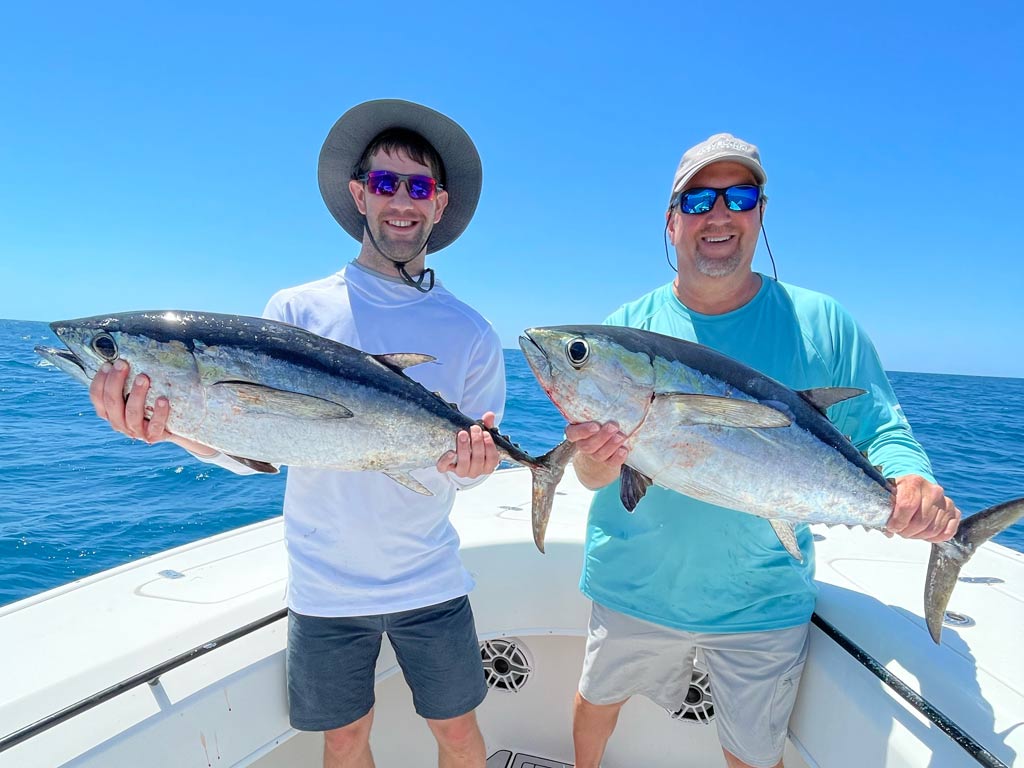
As for the fish that’ll typically bite while you’re trolling, they include Spanish and King Mackerel, Barracuda, Little Tunny, and even Cobia. If you decide to go on a long-range trip, trolling is also an efficient way to entice the bite of Mahi Mahi, Wahoo, Sailfish, Tuna, and other big game species.
Bottom Fishing and Jigging
Bottom fishing and jigging are similar in the sense that they both involve positioning over a prospective spot and lowering your bait vertically. This makes both of them very straightforward and suitable even for beginner anglers.
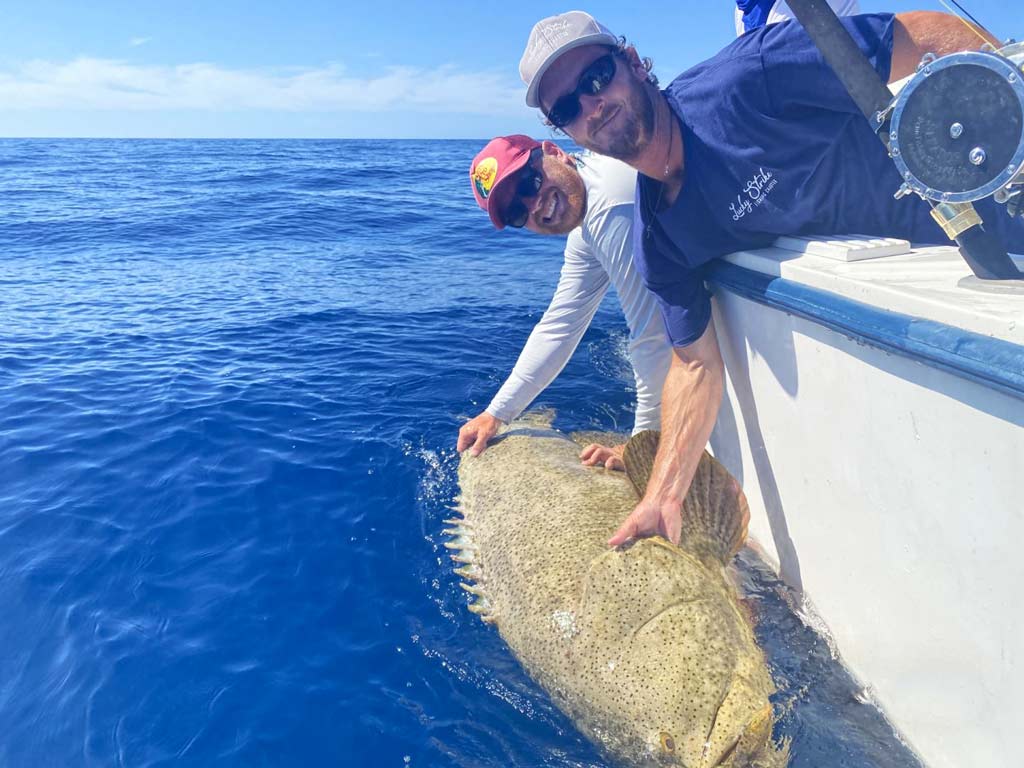
However, the differences lie in the gear you’ll use, as bottom fishing rods are made with a stronger backbone that can hold up against deep-dwelling fish. Conversely, jigging rods are usually softer, making it easier to feel the moment the fish bite as you jig the rod up and down.
You can employ either of these methods when fishing above bottom structures. It mostly depends on what kind of gear your captain prepares, where in the water column the fish are, and your own preferences. Some of the fish you can expect to reel in around the offshore reefs and wrecks include various Snapper and Grouper species, as well as Amberjack.
Spearfishing
The abundance of fish, as well as the sheer number of artificial reefs and wrecks in the area, makes Marco Island a world-class destination for spearfishing. Close to shore, there are many spots that are shallow enough and suitable for beginner spearos. However, to dive the deep sea wrecks, you’ll need plenty of experience.

About 23 miles off the coast of Collier County, you’ll find a 65-deep, 80′ wide sinkhole, called the Blue Hole. To say that this spot offers epic diving is an understatement. Its deep blue waters are both awesome and hair-raising at the same time. Besides that, there are dozens of other offshore dive spots where you can shoot Hogfish, Snapper, and other wreck dwellers. We’ll delve into some of those in the next section, so read on.
Where to Go Deep Sea Fishing in Marco Island

Finally, there’s the question of where to go to reel in all the Marco Island deep sea fish. Of course, your captain will already have an idea of where the bite is. But if you’re keen on learning about the spots you might visit, here are a few common ones.
- 9 Mile Reef: Bordering state and federal waters, the 9 Mile Reef is a popular fishing spot for those who want a taste of offshore action without venturing too far. Snapper, Jack Crevalle, and other reef species, as well as Sharks, can be caught there, offering a nice mix of fish to chase.
- 12 Mile Reef: Just a bit beyond our first entry lies the 12 Mile Reef. Since it’s fairly close, this reef is a solid choice whenever the bite slows down closer to shore. The waters are slightly less pressured since you’re in federal territory, so your chances of putting some fish in the cooler will be better.
- Foote Family Reef: This artificial reef is another spot that offers up nice numbers of Grouper, Snapper, Amberjack, and other bottom species. It’s located 17 miles offshore, meaning you’re now at a distance where you can start looking for hard bottoms and ledges to troll for pelagics.
- The Paddlewheel Wreck: This 150′ deep wreck is found around 30 miles offshore from Marco Island. It’s an interwar boat that lies sunken upside-down. It got its name because the paddlewheel is still visible and preserved. Around here, you’ll see all kinds of fish, including Amberjack, Snapper, Grouper, Sharks, Hogfish, and more.
- Air Force Radio Towers: The seven Air Force Radio Towers are famous both as fishing and diving spots. You won’t have access to all of them, as the last “S” Tower lies 65 miles offshore. However, the “R” Tower is only about 30 miles off the coast and boasts fantastic Black, Red, and Goliath Grouper action. There are also Permit, Snapper, and numerous other fish, here. The other choice is the “T” Tower located 45 miles offshore, which also offers epic fishing.
Marco Island Deep Sea Fishing F.A.Q.
summary { font-size: 18px; font-family: BlinkMacSystemFont, “Segoe UI”, Roboto, Oxygen-Sans, Ubuntu, Cantarell, “Helvetica Neue”, sans-serif;}
Do I need a license to go deep sea fishing in Marco Island?
- Since you’ll be fishing aboard a charter boat, you won’t need to get a license for your deep-sea trips. Anglers aged 16 and older do need a license when fishing solo, however.
What regulations do I need to follow when deep sea fishing in Marco Island?
- Most of the fish you’ll catch in the Gulf of Mexico are subject to size and bag limits. The regulations can change from season to season, so it’s best to check them out prior to each trip. You can find Florida’s state and federal regulations on the myFWC website.
Can I go deep sea fishing in Marco Island as a beginner angler?
- Yes, although, if you haven’t been on a fishing charter before, you can opt for an inshore one first and ease yourself into the world of saltwater angling. However, a short offshore trip is also a solid choice, as it’ll give you an experience of what it’s like to fight deep sea fish without lasting too long.
When is the best time to go deep sea fishing in Marco Island?
- Fishing is a year-round endeavor in Marco Island and there’ll always be fish to go after. So it really depends on what you’d like to catch. If you’re flexible, consult with your captain and they’ll tell you the best time to come.
Marco Island: A Reef Fishing Paradise
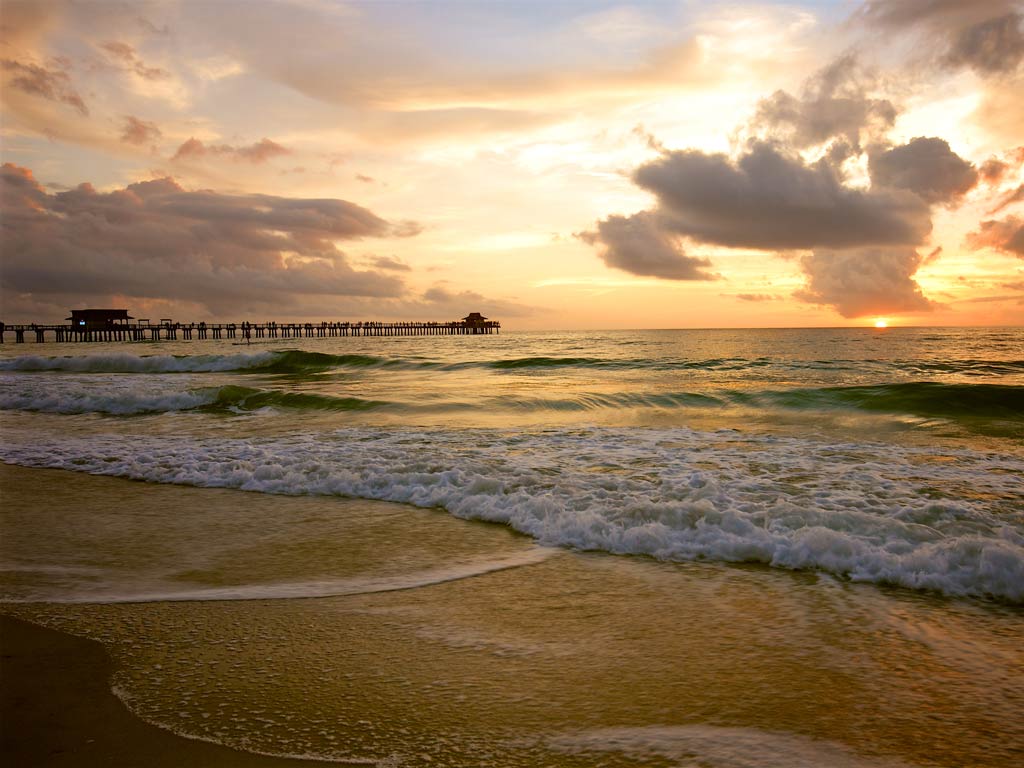
If you’re looking for a healthy variety of reef fish, as well as some pelagics to catch on the side, Marco Island is a great place to start your adventure from. Its offshore reefs and wrecks hold plenty of promise for anglers who want to put some delicious fish in the cooler. And while you’re out there, take a moment to enjoy the surroundings and the beautiful Paradise Coast.
Have you ever been deep sea fishing in Marco Island? Which local species would you like to catch? Let us know in the comments below!
The post Deep Sea Fishing in Marco Island: The Complete Guide appeared first on FishingBooker Blog.
This article originally appeared here and was republished with permission.












